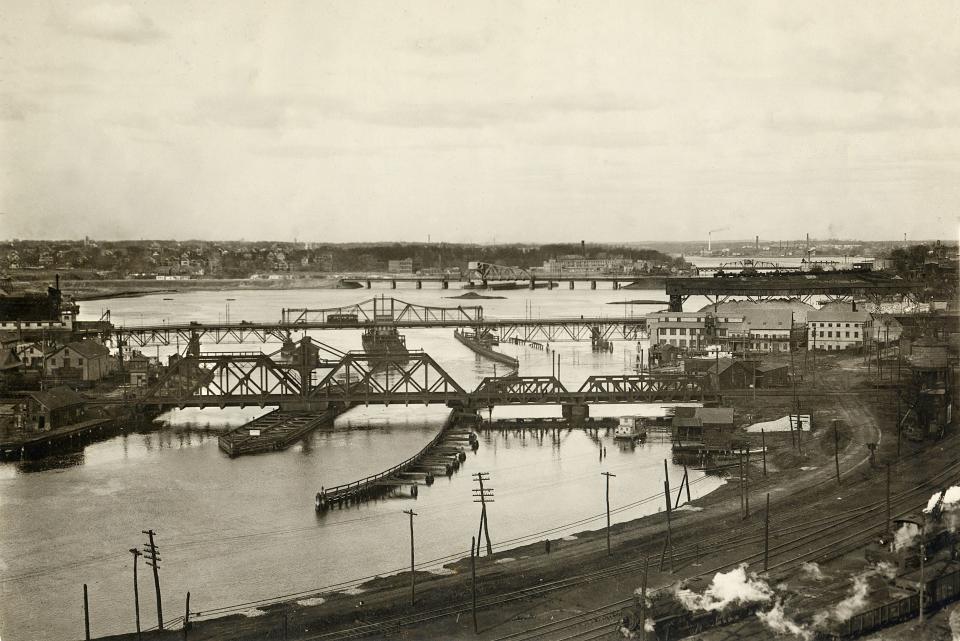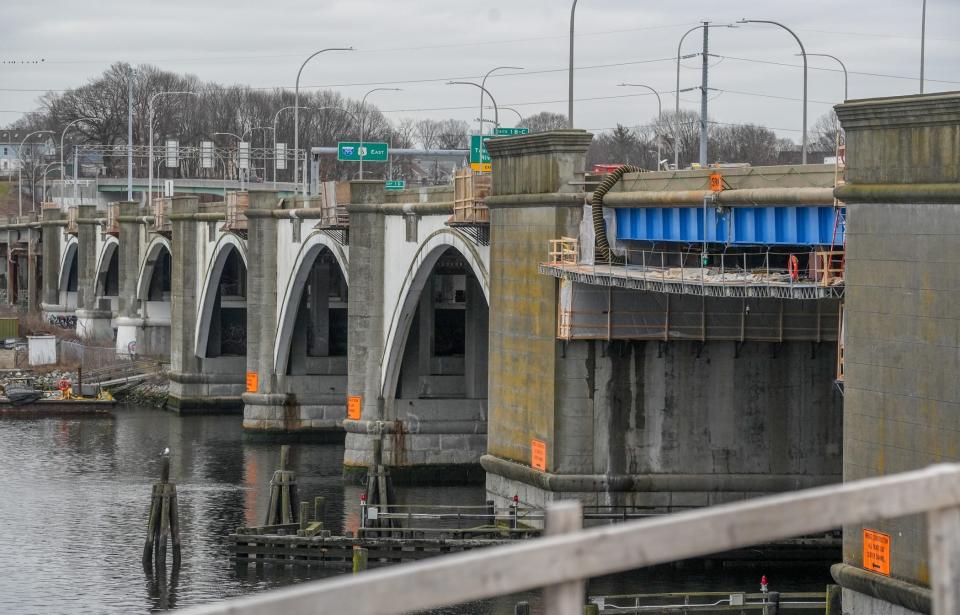'You don't see this every day': Why is the Washington Bridge so strange?
Unique. Old-fashioned. Complex.
Many terms have been used to describe the beleaguered westbound span of the Washington Bridge over the last four months, leading up to Thursday's announcement that its structural problems are unrepairable, requiring its demolition and a $250 million to $300 million multiyear rebuild.
But among civil engineers, the structure comes off as a quirky, one-off antique, a curiosity of another era.
"It's a very complicated structure; it's almost really three different bridges up there," U.S. Federal Highway Administrator Shailen Bhatt told reporters last month after getting an up-close tour of the closed span.
"This has a lot of unique details – unique to just this bridge," said Andrew Bechtel, associate professor in the civil engineering department at The College of New Jersey. "If you're a bridge inspector, you don't see this every day."
"Not a style that we're using any longer," is how Rhode Island Department of Transportation Director Peter Alviti Jr. described the design in the hectic early days of the emergency closure in December.
To a driver zipping, or these days crawling, across the Seekonk River, the Washington Bridge doesn't look particularly exotic.
So what's so weird about it?
The divide between money and aesthetics defines Washington Bridge
The answer goes back more than 60 years to the Vietnam War era and an accountants-versus-aesthetes political fight between Rhode Island and Washington, D.C.
In 1960, America was in the middle of the interstate highway construction boom, and in Rhode Island, bulldozers were plowing through woodlands and neighborhoods to create most of the major highway routes used today.
Once Interstate 95 was finished, Rhode Island transportation officials turned their attention east to building a span across the Seekonk River that would allow the completion of Interstate 195, connecting Providence stoplight-free all the way to Fall River, New Bedford and Cape Cod.
At the time, "Washington Bridge," referred to a neo-classical, concrete and stone, multi-arch bridge connecting India Point in Providence to the Watchemoket Square area of East Providence. That bridge opened in 1930 and replaced a steel-truss swing bridge from 1885. Part of the 1930 bridge now carries the East Bay Bike Path and remains the face of the Washington Bridge from the south.

The 1930 Washington Bridge, while in decent condition and popular for its appearance, could only carry around half the traffic planned for I-195, prompting plans for a second parallel span to the north for vehicles heading west. The 1930 bridge also had a steel drawbridge in the middle that would open for ships passing upriver.
The parallel span would adopt the "Washington Bridge" name, so leaders at the Rhode Island Department of Public Works, the precursor to today's Department of Transportation, assumed the design of the new bridge would make it a "twin" to its older sibling.
However, as the federal government funded thousands of miles of new highways across the country in the 1960s, usually picking up 90% of the cost, budget hawks in Washington were becoming increasingly conscious of the bill state DOTs were racking up.
'Can we afford to spend $1M for aesthetics?'
At some point in late 1963 or early 1964, as the design for the new Washington Bridge span was being hammered out, the U.S. Bureau of Public Roads under President Lyndon B. Johnson objected to paying for another concrete arch bridge to match the 1930s bridge.
Federal highway officials suggested that a new steel bridge across the Seekonk River would save taxpayers around $1 million.
But Rhode Island Public Works Director Angelo A. Marcello wasn't having it. He described the juxtaposition of a steel bridge next to a concrete bridge as a "monstrosity" and vowed to fight for the more beautiful option, and also that Rhode Island would not pay any premium for it.
"Can we afford to spend $1 million for aesthetics?” Robert Kellum, Johnson’s highway beautification chief asked in May 1965 as the dispute dragged into its second year.
At one point, the Bureau of Public Roads offered to pay for part of the cost of concrete arches, but Marcello turned down the offer, which would have cost the state $568,000. (This was the same year Congress passed the Highway Beautification Act after a campaign led by first lady "Lady Bird" Johnson.)

A compromise – the look of concrete arches for the price of steel
In August 1965, Marcello came up with a new compromise. Using new construction techniques, the state could build a new Washington Bridge span that looked like the old 1930 bridge but cost more like a steel bridge.
The compromise involved a "precast concrete girder design with a false concrete arch exterior that would look like the present [1930] bridge but would cost much less than an exact reproduction," is how The Journal described it in 1965.
The Bureau of Public Roads agreed to study Marcello's idea, and on Jan. 21, 1966, agreed to it: "pre-stressed concrete with false arches."
Gov. John Chafee broke ground on the new bridge on April 24, 1967, and opened it to automobiles two days before Christmas in 1968.
So how does it work?
The resulting bridge that served motorists for more than five decades, until engineers found potentially catastrophic structural failings in December, is made up of more than a dozen of those pre-stressed concrete spans on either side of a central steel span that echoes the 1930s drawbridge.
A draft report last month from VN Engineering on the bridge's condition described the bridge as "unique from a national perspective" and said prestressed and post-tensioned concrete in infrastructure projects "emerged after World War II and became more readily used during the 1950s."
"Therefore, only about two decades of industrial knowledge on the performance, maintenance, inspection, and repair of post-tensioned concrete structures could be used to inform the design, detailing, and construction of the Washington Bridge," the report said.
Befitting the compromise that spawned it, the 1960s spans are a marriage of steel and concrete designed to maximize the advantages of both materials.
Each bridge section is made up of concrete beams with steel cables running through ducts inside it. On the end of each beam, the steel cables are tightened, compressing the concrete, and locked in place with steel anchors before they are dropped onto the bridge. This is the post-tensioning.
The web of tightened steel cables inside the concrete makes the beams much stronger than they would be with just concrete and prevents them from bending and cracking under a heavy, moving load, according to the VN report.
In addition to the post-tensioning cables, the bridge also features steel tie-down rods running vertically through some beams to hold them in place. This is important, because some of the beams, particularly those on either side of the central steel section, are "unbalanced," with more force load on one side than the other.
But the post-tensioning system relies on both the concrete and the steel running through it to maintain strength.
Inspections of the bridge since December show water infiltration inside the concrete and likely damage to the steel inside, in addition to the broken tie-down rods that initially triggered the closure.
"This bridge was built in a transitional era, going from like the 1950s to probably the 1970s, in a time when they were pre-casting and post-tensioning the bridges," Bechtel, at The College of New Jersey, said. "We generally don't use post-tensioning on bridges that much anymore."
If either Rhode Island or the federal Bureau of Public Roads had had its way in the mid-1960s, the Washington Bridge wouldn't have used the unusual design either.
When he came up with his compromise design in 1965, Marcello said the delay in construction that had already elapsed at that point had likely already cost the public a large share of the difference to the state's estimated cost of building concrete instead of steel.
"Ironically, much, if not all, of the $568,000 difference will be wiped out before we are through with this project because of the changes and the delay," he said.
With staff reports from Mark Reynolds.
This article originally appeared on The Providence Journal: Why Rhode Island's Washington Bridge is so complex, and strange
Solve the daily Crossword

